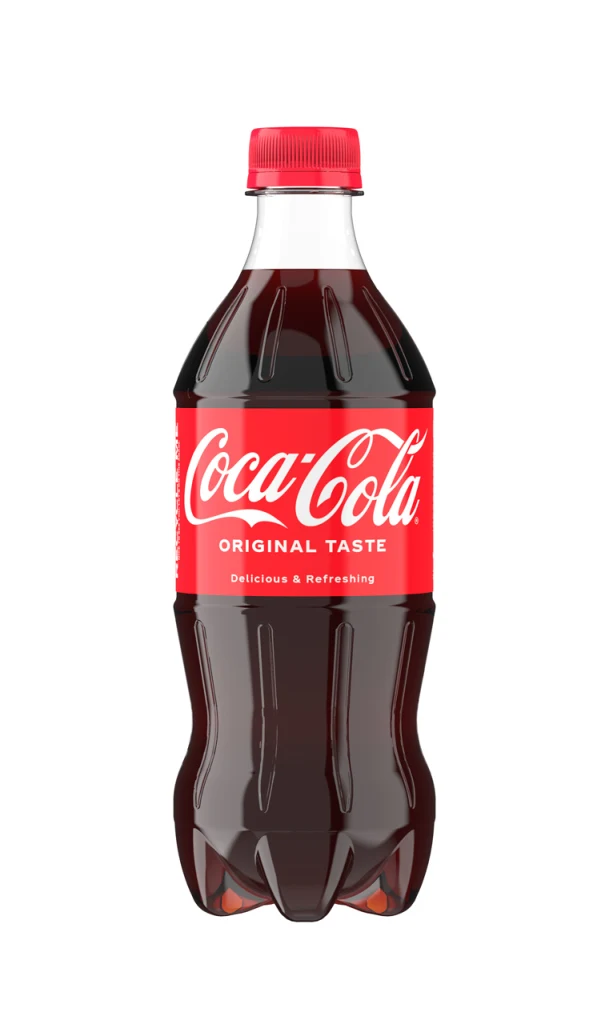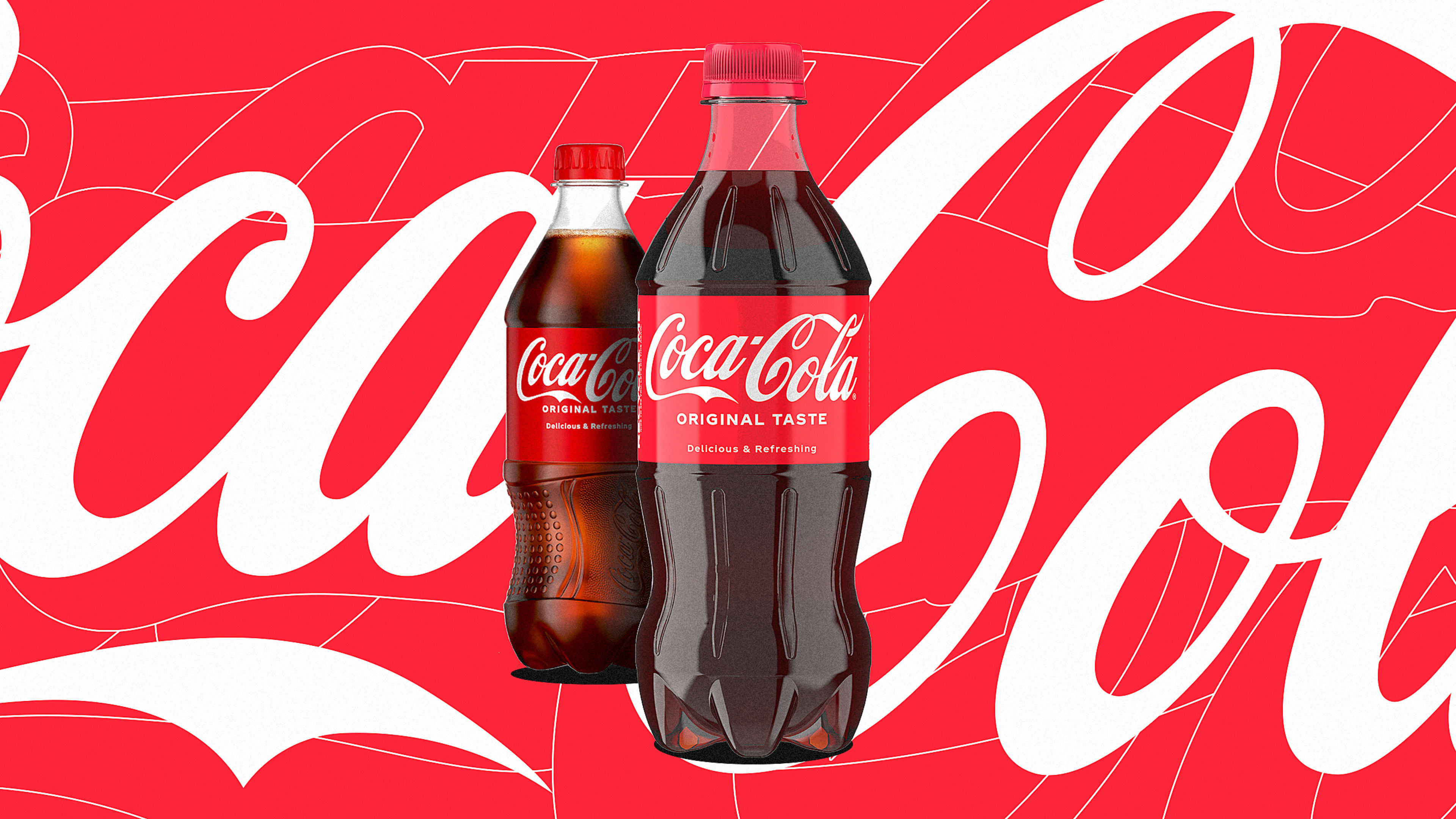Next time you grab a Diet Coke on the go, take a moment to look at the plastic bottle you have in your hand.
The Coca-Cola Co. is rolling out three new bottle designs for Coca-Cola, Sprite, and brands like Fanta, and Minute Maid, which Coca-Cola Co. also owns. While each bottle is slightly different, they have one common denominator: All are now 2.5 grams lighter than they used to be.
If you’re a Coke connoisseur, you’ll notice that the new 12-oz. bottle has lost the 3D pattern it sported on its lower half and gained the same fluted elements as its 16.9-oz. counterpart. If you drink a lot of Fanta, you’ll see that the label has moved from the bottom half to the top half of the bottle for brand visibility, and that the lower half now comes with a grippy texture that is reminiscent of fizzing bubbles. All three bottles sport a unifying look with the same pinched silhouette for ergonomics and a label at the same height.

A shrinking bottle
About 10 years ago, a plastic Coca-Cola bottle weighed 27 grams. In 2023, it weighted 21 grams. Now, it weighs 18.5 grams—the lightest it’s ever been. The shift in packaging aligns with the company’s goal to reduce the amount of virgin PET plastic it uses while increasing the amount of recycled PET. Coca-Cola still has a long way to go. In 2022, the company used just 17% of recycled PET in its North America bottles and is targeting 20% to 22% this year, with the goal of reaching 50% of recycled content by 2030.
In other words, the bulk of the company’s production still requires virgin plastic. Every time you reach for your favorite soda, you’re drinking from a container made primarily of crude oil. But less weight means less plastic, which ultimately means less petroleum. And even though a mere 2.5 grams seems inconsequential on its own, the impact skyrockets when you take into consideration the fact that Coca-Cola Co. is the world’s largest beverage manufacturer and distributor in the world.
The company estimates that the new bottles, which (for now) are only rolling out in the North American market, will help the company reduce the amount of CO2 it produces per year by 81,000 tons, or the equivalent of taking nearly 17,000 cars off the road. The transition to lighter-weight bottles is projected to reduce the use of new plastic by the equivalent of 800 million bottles in 2025 versus 2024.
The road to a lighter bottle
Coca-Cola Co. has been working to lighten its bottles for almost a decade, shaving half a gram here, half a gram there. The problem is that the lighter and thinner the bottle, the faster its beloved carbonation will escape through the lining of the bottle. As a result, when you twist the cap, you might hear a disappointing whoosh instead of a glorious fizz.
A Coke won’t go flat the minute you use a bottle made with thinner plastic. That happens over time. Alejandro Santamaria, senior director for global packaging development and innovation at Coca-Cola Co., explains that every bottle has a shelf life. The longer it sits unopened on a shelf, the flatter it gets.
This means that every time the team reduces the weight of the bottle, they are reducing its shelf life and sending bottlers into a tizzy to get through every step of the production process with enough time for the soda to preserve its carbonation. In previous years, when the team shaved one gram off the bottle, they reduced the soda’s shelf life by about a week. Now, they were was able to shave off 2.5 grams without reducing the product’s shelf life at all.

To understand how they pulled this off, it’s helpful to understand the production process of a PET bottle. First, a machine injects melted resin into a test tube that is called a preform. That preform will eventually turn into a bottle, but at this stage, it looks like the oblong test tubes you might find in a lab. These preforms are then sent to bottlers around the U.S., where they are placed into a machine that heats them up, then blows them, like balloons, into predesigned molds. Finally, they solidify in the desired shape of the bottle.
Previously, every time the company lightened the bottle, it simply reduced the preform’s thickness, a bit like slicing a salami, says Santamaria. This time, the team changed the actual shape and aspect ratio of the preform. To help bottlers scale up the new designs, they made sure that one preform could be used for all three bottle shapes, and in all 12-, 16.9- and 20-oz. sizes. Using computer modeling, they created dozens of digital preforms and simulated performance tests based on the most optimal length, diameter, and thickness of the preform (which is not uniform across the entire tube). Based on those findings, they built a physical “uni-cavity mold,” or a prototype preform used for tests and to ensure that neither flavor nor carbonation would be compromised.
A new bottle coming to a store near you
The company started rolling out the new bottles in March and expects the process to be complete by the end of the year. For now, Santamaria says the team has reached the new floor in terms of weight. Making a lighter, thinner bottle is theoretically possible, but it would require compressing the supply chain to a point that, currently, is unattainable.
A thinner bottle may also leave some customers disappointed. Santamaria says the team ran both quantitative and qualitative surveys, plus focus groups with about 1,000 people to explore how people felt about the new designs. He says that they got positive feedback, but that they’re reaching a point where consumers are starting to notice. “We want to make sure we don’t introduce a negative component from a flimsy bottle,” he says.
I, for one, would take a flimsy bottle of Diet Coke over a sturdier one any day if it meant that it took half the amount of petrol to make it.
Recognize your brand’s excellence by applying to this year’s Brands That Matter Awards before the early-rate deadline, May 3.
